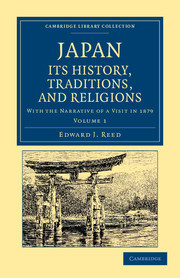Description
Japan: Its History, Traditions, and Religions
With the Narrative of a Visit in 1879
Japan: Its History, Traditions, and Religions 2 Volume Set Series
Author: Reed Edward J.
Published in 1880, this is a first-hand account of early Meiji Japan and one of the first histories of Japan in English.
Language: English
Subject for Japan: Its History, Traditions, and Religions:
Publication date: 03-2012
442 p. · 14x21.6 cm · Paperback
442 p. · 14x21.6 cm · Paperback
Description
/li>Contents
/li>
As Chief Constructor of the Royal Navy, Sir Edward Reed (1830?1906) oversaw the final move from wooden to ironclad ships. Upon resigning from the Navy in 1870 he designed warships for Germany, Chile, Brazil and Japan, and was invited to Japan in 1879 to advise its government on plans to strengthen its navy. Eleven years after the restoration of the monarchy, the country was embarking on a period of rapid industrial and military development. Published in 1880, and part history, part travel narrative, Reed's book gives a fascinating insight into Japan during a key period in her history and is an informal yet informed assessment of its people, customs, history and geography. Volume 1 covers the geography and history of Japan, including its mythology and the origins of its religions. It concludes with a valuable assessment by Reed of the political, social and industrial reforms and developments that he witnessed.
Preface; Note on the spelling and pronunciation of Japanese names; Introduction; 1. The land and its inhabitants; 2. The God-period; 3. The Shinto religion; 4. Buddhism in Japan; 5. The descent of the Crown; 6. Early history ending 1000 A.D.; 7. The Taira and the Minamoto. The wars of the red and white flags, 1000–1200 A.D.; 8. The Hojo domination; 9. The simultaneous dynasties; 10. The Ashikaga shoguns; 11. Nobunaga and Hideyoshi; 12. Iyéyasu, the first Tokugawa Shogun; 13. The Tokugawa period (1603–1868); 14. The revival of the imperial power; 15. The fall of the shogun; 16. The imperial restoration completed; 17. Foreign relations of Japan; 18. The reforms of the last ten years; 19. The Satsuma Rebellion; 20. The Emperor and the existing government.
© 2024 LAVOISIER S.A.S.
These books may interest you

Minding the South 105.47 €



